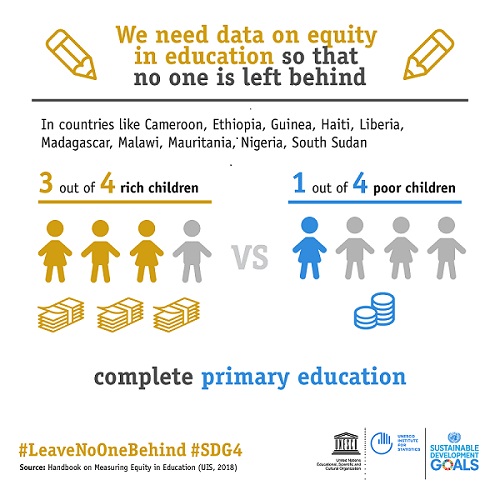
GCED Basic Search Form
Quick Search
You are here
News
Methodologies and indicators to reveal the inequalities facing marginalized groups
A new report shows how countries can measure the education progress of the most marginalized populations to ensure no one is left behind. Sustainable Development Goal 4 (SDG 4) calls for inclusive and equitable quality education for all, spanning not only gender parity in learning but also equitable educational opportunities for persons with disabilities, indigenous peoples, disadvantaged children and others who are at risk of exclusion from education. Yet today, these groups are extremely difficult to track because they are often invisible in education data.
The new Handbook on Measuring Equity in Education, produced by the UNESCO Institute for Statistics (UIS), the FHI 360 Education Policy Data Centre, Oxford Policy Management and the Research for Equitable Access and Learning (REAL) Centre at the University of Cambridge, provides practical guidance on the calculation and interpretation of indicators designed to target the most disadvantaged groups. It is intended for anyone involved in the measurement and monitoring of equity in education, especially those concerned with national policymaking. It addresses the current knowledge gaps and provides a conceptual framework to measure equity in learning, drawing on examples of equity measurement across 75 national education systems.
The handbook explains what it means to measure equity in learning, recognising that equity itself is a political issue and cannot be isolated from political choices. It focuses on two key principles – impartiality and equality of condition.
Impartiality zooms in on the idea that it is unfair to discriminate by characteristics such as gender, wealth or ethnicity when it comes to the distribution of education. Measures of impartiality quantify the extent to which an educational input or outcome differs by such characteristics.
Equality of condition focuses on the dispersion of education in the population, without regard for differences between groups. While perfect equality of condition in education outcomes might not be possible or desirable, wide or growing gaps between the least and most educated are likely to be a cause for concern.
The handbook introduces visualization and measurement techniques related to impartiality and equality of condition, the requirements for the use of underlying data to measure both, and the advantages and disadvantages of each technique for generating insights into the magnitude and nature of any inequality. It provides solid examples of national efforts to track progress towards equity in both educational access and learning, highlighting positive country examples and stressing the need to include a wider range of dimensions of disadvantage in education plans.
Allocating education funding more equitably
Finally, the handbook examines government spending on education to reveal who benefits, who misses out, and how resources could be redistributed to promote equity. It points out that in many countries, the children and young people who are the hardest to reach are often the last to benefit from government spending. It is simply more expensive to ensure their quality education, given the cost of measures to tackle the root causes of their disadvantage, from poverty to discrimination – and this should inform the distribution of resources.

While equal funding means the same amount of money for each student or school, equitable funding means additional resources for the most disadvantaged children to ensure that every child can enjoy the same educational opportunities. As the handbook argues, progress towards SDG 4 demands the equitable distribution of resources within education systems, with the most disadvantaged receiving the largest share of government resources, and paying the smallest share from their own pockets.
The new handbook has been inspired by the urgent need to position educational equity at the heart of global, national and local agendas to promote access and learning for all children, young people and adults. With countries under pressure to deliver data on an unprecedented scale, the handbook also recognises that no country can do this alone, making a strong case for greater cooperation and support across governments, donors and civil society.
URL:
http://uis.unesco.org/en/news/new-report-how-measure-equity-education
